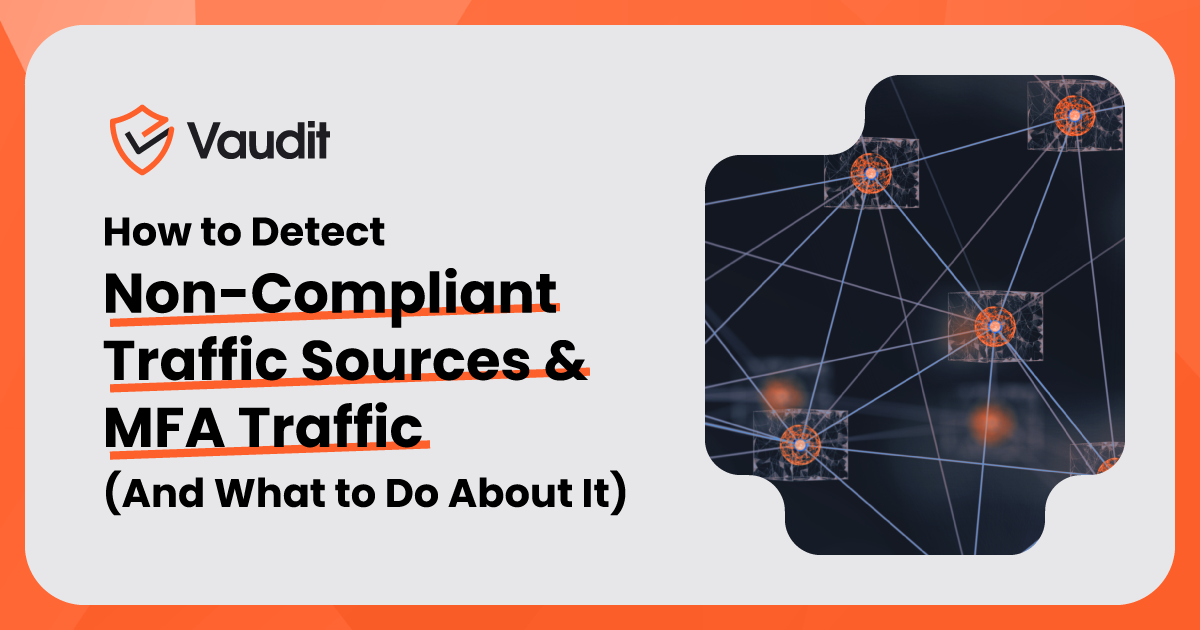Press Release
Published at
December 4, 2025
Vaudit Surpasses $1 Billion in Digital Ads Audited in 2025 and $100 Million in Refunds Identified for Global Brands Including Accenture, HP, Panasonic, and Volkswagen

The Hidden Cost of Cheap Reach
Marketers love scale. But in the race for impressions and clicks, many campaigns silently bleed budget on non-compliant traffic sources - traffic that never had a real chance of converting in the first place.
Among the most problematic offenders?
Made for Advertising (MFA) traffic: websites and apps engineered solely to monetize ads, not to deliver value or engage real users.
This isn’t just a media quality issue.
It’s a strategic threat to your marketing ROI, data integrity, and performance benchmarking.
What Is Non-Compliant Traffic?
Non-compliant traffic refers to any source, session, or visitor that violates the basic terms of your ad buy, either geographically, technically, or behaviorally. It may still get billed. But it shouldn’t.
This includes:
Even the most well-optimized campaigns can bleed budget if your traffic sources include bots, click farms, MFA pages, or other low-quality placements. These traffic patterns not only inflate your CPAs and ROAS but also distort attribution models and learning algorithms.
What Are MFA Sites?
Made-for-Advertising websites are engineered not to deliver value to users, but to maximize ad impressions and clicks through deceptive UI patterns and thin, low-value content.
These sites often:
Signs You're Dealing with Non-Compliant Traffic or MFA Sites
These aren’t just quality issues, they are financial liabilities.
The Real Problem: Platforms Bill First, Investigate Later
Platforms like Google and Meta charge immediately for all traffic, even from these sources. Only after billing do they sometimes issue small credits for what they retroactively classify as invalid - see Meta’s own policy.
But by then, your budget is already gone and performance data is already skewed.
Why MFA Traffic Is Especially Dangerous
MFA traffic is designed to mimic engagement but never delivers results. These websites often:
Your campaign might look like it’s performing but conversions are nowhere in sight. Meanwhile, you’ve paid for every click.
The Impact on Your Campaigns
If you’re not filtering non-compliant sources:
How to Detect Non-Compliant Traffic & MFA Sources
Here’s what to audit, daily or weekly:
Non-compliant traffic sources - Spike in long-tail or low-authority sites
Why?: MFA domains are often hidden in longtail
Non-compliant traffic sources - Multiple user agents per IP
Why?: Indicates bots/emulation farms
Non-compliant traffic sources - Display traffic acting like search
Why?: Suggests spoofed sources
Session Violations - Page load but no scroll, click, or view event
Why?: Click fraud or accidental taps
Session Violations - 5+ sessions from same IP in 60 sec
Why?: Automated traffic pattern
Geo Violations - Clicks from regions outside your target
Why?: Breaches of campaign setup
What to Do About It: The Vaudit Approach
Real-Time Detection: Vaudit’s engine flags invalid sessions before they hit your bill, tracking user agents, session behavior, and source domains in real time.
Geo & Device Flagging: Our pre-charge audit identifies out-of-geo traffic, device spoofing, and MFA domains before you pay.
Exclusion Lists & Prevention: Non-compliant traffic is pushed to exclusion audiences (e.g., Meta), blocked via IP, or auto-flagged in reconciliation workflows.
Legal-Grade Evidence: If it gets billed, our audit trail helps you challenge charges with documentation that meets internal finance and legal standards. Understand more about what charges could be disputed here.
Why This Matters for Marketing Executives
As a marketing leader, you’re accountable for two things:
That means eliminating traffic that doesn’t belong, regardless of what the ad platforms say. It’s time to move beyond click-through rates and start asking “Was this click even legitimate?”
Audit Your Campaigns for MFA & Non-Compliant Traffic
Start your 15-day free trial and uncover what shouldn’t be on your bill.